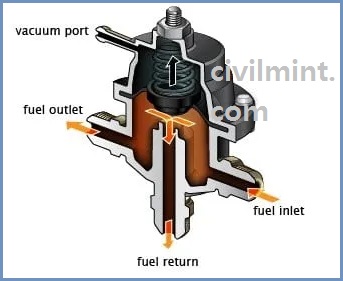A fuel pressure regulator is a mechanical device that maintains a stable fuel supply even when fuel demand changes significantly. The fuel regulator diaphragm has two sides.
Of those sides, one facet gets strain from the gas rails and the opposite facet gets vacuum strain from the consumption port among the intake port and the throttle body. The fuel strain pressure adjusts the gas strain primarily based on barometric drive. This lets the injector hold the maximum suitable fuel to reinforce the ratio.

How Does Fuel Pressure Regulator Work?
The fuel pressure regulator has an easy layout and work. It has a diaphragm that handles the “ball seat” of the bypass valve. This valve opens or closes to regulate the stable fuel supply.
A spring is linked to the diaphragm. This spring contains a spring rate set. You can adjust the fuel pressure by adjusting the internal spring tension. The pressure in the fuel rails downstream of the fuel injector is determined by the spring setting in the regulator.

When pressure is applied to the diaphragm connected to the bypass valve at the top of the regulator, the spring pushes down the diaphragm to reduce the amount of excess fuel, and the plenum rises linearly. When the spring is released, the fuel pressure drops. Allowing more fuel pressure to flow to the return side will reduce the fuel pressure on the supply side. On the other hand, reducing the amount of fuel emitted increases the pressure.
How to Clean Fuel Pressure Regulator
Here is the complete step-by-step process to clean the fuel pressure regulator.
- Turn off the power.
- Relieves pressure in the fuel system.
- Remove the holding bracket.
- Delete the O-Ring.
- Clean the fuel pressure regulator.
- Reconnect the parts.
